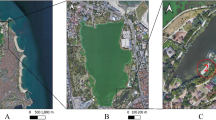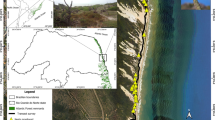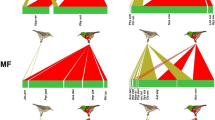Abstract
The decision to emigrate from the natal area can influence future fitness prospects, yet detailed data on sex-specific juvenile dispersal behaviour is still lacking for most bird species. We tracked 13 radio-tagged Tengmalm’s Owl Aegolius funereus juveniles from 13 different nests from fledging to independence and onwards. Six out of the seven female juveniles departed abruptly and disappeared from the natal area. In contrast, only one male juvenile departed abruptly, whereas the other five males and one female remained in the study area until tracking was terminated. We propose two alternative interpretations: (1) females initiated natal dispersal earlier than males, or (2) the manner of dispersal differed between the sexes, with females departing abruptly, and males moving gradually out of the natal area. We found no statistically significant influence of body condition or date of independence on dispersal behaviour. We suggest that early onset of dispersal and fast movements out of the natal area may increase a juvenile female’s chances of successful breeding in the following spring. In contrast to females, male Tengmalm’s Owls rarely breed as 1-year-olds, and the benefits of early/abrupt dispersal may be lower for juvenile males. We suggest that female-biased natal dispersal in Tengmalm’s Owl may come about through relatively higher lifetime reproductive success of early dispersing in females than in males.
Zusammenfassung
Geschlechtsspezifische Unterschiede in der frühen Jugendstreuung: Abruptes Verlassen bei Weibchen und graduelles Abwandern bei Männchen beim Raufußkauz Aegolius funereus
Die Entscheidung zur Abwanderung vom Geburtsort kann die zukünftige Fitness beeinflussen. Dennoch fehlen detaillierte Daten zum geschlechtsspezifischen Abwanderungsverhalten der Jungvögel bei den meisten Vogelarten. Wir haben 13 junge Raufußkäuze Aegolius funereus aus 13 verschiedenen Nestern vom Ausfliegen bis zum Selbständigwerden und darüber hinaus telemetriert. Sechs der sieben jungen Weibchen verließen den Geburtsplatz abrupt. Dagegen verschwand nur ein Männchen abrupt, wogegen die anderen fünf Männchen und das eine Weibchen bis zum Ende der Untersuchung im Gebiet verblieben. Wir schlagen zwei alternative Hypothesen vor: (1) Weibchen beginnen mit der Jugendstreuung früher als Männchen, oder (2) die Geschlechter unterscheiden sich in der Art und Weise der Abwanderung, wobei die Weibchen abrupt abwandern, die Männchen dagegen graduell. Wir fanden keine signifikanten Einflüsse der Körperkondition oder des Zeitpunktes des Selbständigwerdens auf das Abwanderungsverhalten. Wir vermuten, dass das frühe und rasche Abwandern der Weibchen ihre Aussichten auf erfolgreiches Brüten im kommenden Frühjahr erhöht. Männliche Raufußkäuze brüten dagegen nur selten schon als Einjährige, weshalb bei ihnen die Vorteile eines frühen und abrupten Abwanderns geringer sind. Wir vermuten weiterhin, dass das frühere Abwandern der jungen Weibchen des Raufußkauzes einhergeht mit einem im Vergleich zu den Männchen höheren Lebenszeitbruterfolg.

Similar content being viewed by others
References
Balbontín J, Ferrer M (2009) Movements of juvenile Bonelli’s eagles Aquila fasciata during dispersal. Bird Study 56:86–95
Belthoff JR, Dufty AM Jr (1998) Corticosterone, body condition and locomotor activity: a model for dispersal in screech-owls. Anim Behav 55:405–415
Bennetts RE, Nichols JD, Lebreton R, Pradel R, Hines JE, Kitchens WM (2001) Methods for estimating dispersal probabilities and related parameters using marked animals. In: Clobert J, Danchin AA, Dhondt AA, Nichols (eds) Dispersal. Oxford University Press, New York, pp 3–17
Bonte D, de la Pena E (2009) Evolution of body condition-dependent dispersal in metapopulations. J Evol Biol 22:e1242–e1251. doi:10.1111/j.1420-9101.2009.01737.x
Bonte D, Van Dyck H, Bullock JM, Coulon A, Delgado M, Gibbs M, Lehouck V, Matthysen E, Mustin K, Saastamoinen M, Schtickzelle N, Stevens VM, Vandewoestijne S, Baguette M, Barton K, Benton TG, Chaput-Bardy A, Clobert J, Dytham C, Hovestadt T, Meier CM, Palmer SCF, Turlure C, Travis JMJ (2012) Costs of dispersal. Biol Rev 87:290–312. doi:10.1111/j.1469-185X.2011.00201.x
Bowler DE, Benton TG (2005) Causes and consequences of animal dispersal strategies: relating individual behaviour to spatial dynamics. Biol Rev 80:205–225. doi:10.1017/S1464793104006645
Brommer J, Kokko H, Pitiäinen H (2000) Reproductive effort and reproductive values in periodic environments. Am Nat 155:454–472. doi:10.1086/303335
Cadahía L, López-López P, Urios V, Negro JJ (2008) Estimating the onset of dispersal in endangered Bonelli’s eagles Hieraaetus fasciatus tracked by satellite telemetry: a comparison between methods. Ibis 150:416–420. doi:10.1111/j.1474-919x.2007.00781.x
Cadahía L, López-López P, Urios V, Negro JJ (2010) Satellite telemetry reveals individual variation in juvenile Bonelli’s eagle dispersal areas. Eur J Wildl Res 56:923–930. doi:10.1007/s10344-010-0391-z
Clarke AL, Sæther B-E, Røskaft E (1997) Sex biases in avian dispersal: a reappraisal. Oikos 79:429–438
Clobert J, Le Galliard J-F, Cote J, Meylan S, Massot M (2009) Informed dispersal, heterogeneity in animal dispersal syndromes and the dynamics of spatially structured populations. Ecol Lett 12:197–209. doi:10.1111/j.1461-0248.2008.01267.x
Delgado MM, Penteriani V (2008) Behavioral states help translate dispersal movements into spatial distribution patterns of floaters. Am Nat 172:475–485. doi:10.1086/590964
Delgado MM, Penteriani V, Nams VO, Campioni L (2009a) Changes of movement patterns from early dispersal to settlement. Behav Ecol Sociobiol 64:35–43. doi:10.1007/s00265-009-0815-5
Delgado MM, Penteriani V, Nams VO (2009b) How fledglings explore surroundings from fledging to dispersal. Ardea 97:7–15
Delgado MM, Penteriani V, Revilla E, Nams VO (2010) The effect of phenotypic traits and external cues on natal dispersal movements. J Anim Ecol 79:620–632. doi:10.1111/j.1365-2656.2009.01655.x
Derr RE (2000) Performing exact logistic regression with the SAS® system. In: Proc Twenty-Fifth Annual SAS® Users Group International Conference, paper P254–25, pp 1–10
Eldegard K, Sonerud GA (2009) Female offspring desertion and male-only care increase with natural and experimental increase in food abundance. Proc R Soc Lond B 276:1713–1721. doi:10.1098/rspb.2008.1775
Eldegard K, Sonerud GA (2010) Experimental increase in food supply influences the outcome of within-family conflicts in Tengmalm’s Owl. Behav Ecol Sociobiol 64:815–826. doi:10.1007/s00265-009-0898-z
Eldegard K, Sonerud GA (2012) Sex roles during post-fledging care in birds: female Tengmalm’s owls contribute little to food provisioning. J Ornithol 153:385–398. doi:10.1007/s10336-011-0753-7
Forero M, Donázar JA, Hiraldo F (2002) Causes and fitness consequences of natal dispersal in a population of black kites. Ecology 83:858–872
Fridolfsson AK, Ellegren H (1999) A simple and universal method for molecular sexing of non-ratite birds. J Avian Biol 30:116–121
Ganey JL, Block WM, Dwyer JK, Strohmeyer BE, Jenness JS (1998) Dispersal movements and survival rates of juvenile Mexican spotted owls in northern Arizona. Wilson Bull 110:206–217
Gienapp P, Merilä J (2011) Sex-specific fitness consequences of dispersal in Siberian jays. Behav Ecol Sociobiol 65:131–140. doi:10.1007/s00265-010-1017-x
Greenwood PJ (1980) Mating systems, philopatry, and dispersal in birds and mammals. Anim Behav 28:1140–1162
Hakkarainen H, Korpimäki E (1994) Nest defence of Tengmalm’s Owls reflects offspring survival prospects under fluctuating food conditions. Anim Behav 48:843–849
Hakkarainen H, Korpimäki E, Koivunen V, Ydenberg R (2002) Survival of male Tengmalm’s Owls under temporally varying food conditions. Oecologia 131:83–88. doi:10.1007/S00442-001-0865-5
Hernández-Matías A, Real J, Pradel R, Ravayrol A, Vincent-Martin N, Bosca F, Cheylan G (2010) Determinants of territorial recruitment in Bonelli’s eagle (Aquila fasciata) populations. Auk 127:173–184
Hörnfeldt B, Carlsson B-G, Löfgren O, Eklund U (1990) Effects of cyclic food supply on breeding performance in Tengmalm’s Owl (Aegolius funereus). Can J Zool 68:522–530
Hörnfeldt B, Hipkiss T, Eklund U (2005) Fading out of vole and predator cycles? Proc R Soc Lond B 272:2045–2049. doi:10.1098/rspb.2005.3141
Kenward RE (2001) A manual for wildlife radio tagging. Academic, London
Kontiainen P, Pietiäinen H, Huttunen K, Karell P, Kolunen H, Brommer JE (2009) Aggressive Ural owl mothers recruit more offspring. Behav Ecol 20:789–796. doi:10.1093/beheco/arp062
Korpimäki E (1989) Mating system and mate choice of Tengmalm’s Owls Aegolius funereus. Ibis 131:41–50. doi:10.1111/j.1474-919X.1989.tb02742.x
Korpimäki E, Hakkarainen (2012) The boreal owl: ecology, behaviour and conservation of a forest-dwelling predator. Cambridge University Press, Cambridge
Korpimäki E, Lagerström M (1988) Survival and natal dispersal of fledglings of Tengmalm’s Owl in relation to fluctuating food conditions and hatching date. J Anim Ecol 57:433–441
Limiñana R, García JT, González JM, Guerrero Á, Lavedán J, Moreno JD, Román-Muñoz A, Palomares LE, Pinilla A, Ros G, Serrano C, Surroca M, Tena J, Arroyo B (2012) Philopatry and natal dispersal of Montagu’s harriers (Circus pygargus) breeding in Spain: a review of existing data. Eur J Wildl Res 58:549–555. doi:10.1007/s10344-011-0602-2
Löfgren O, Hörnfeldt B, Carlsson BG (1986) Site tenacity and nomadism in Tengmalm’s Owl (Aegolius funereus (L.)) in relation to cyclic food production. Oecologia 69:321–326
Morrison JL, Wood PB (2009) Broadening our approaches to studying dispersal in raptors. J Raptor Res 43:81–89. doi:10.3356/JRR-08-33.1
Nilsson J-Å (1989) Causes and consequences of natal dispersal in the marsh tit, Parus palustris. J Anim Ecol 58:619–636
Penteriani V, Delgado MM (2011) Birthplace-dependent dispersal: are directions of natal dispersal determined a priori? Ecography 34:729–737. doi:10.1111/j.1600-0587.2010.06773.x
Serrano D, Tella JL, Donázar JA, Pomarol M (2003) Social and individual features affecting natal dispersal in the colonial lesser kestrel. Ecology 84:3044–3054
Sonerud GA, Solheim R, Prestrud K (1988) Dispersal of Tengmalm’s Owl Aegolius funereus in relation to prey availability and nesting success. Ornis Scand 19:175–181
Soutullo A, Urios V, Ferrer M, Peñarrubia SG (2006) Post-fledging behaviour in golden eagles Aquila chrysaetos: onset of juvenile dispersal and progressive distancing from the nest. Ibis 148:307–312
Steen H, Ims RA, Sonerud GA (1996) Spatial and temporal patterns of small-rodent population dynamics at a regional scale. Ecology 77:2365–2372
Sundell J, Huitu O, Henttonen H, Kaikusalo A, Korpimäki E, Pietiäinen H, Saurola P, Hanski I (2004) Large-scale spatial dynamics of vole populations in Finland revealed by the breeding success of vole-eating avian predators. J Anim Ecol 73:167–178. doi:10.1111/j.1365-2656.2004.00795.x
Svensson L (1992) Identification guide to European passerines. Svensson, Stockholm
Willey DW, Van Riper C (2000) First-year movements by juvenile Mexican spotted owls in the canyonlands of Utah. J Raptor Res 34:1–7
Acknowledgments
We thank O. Heie for assistance in the field; R. Bjørnstad, G.C. Nyhus, the late F. Rønning, K. Skjærvik, O. Skjærvik, T. Wernberg and E. Østby for finding some of the of owl nests; G. Bjørnstad for DNA extraction; and J. Beheim and H. Klungland for analysing blood samples. We also thank Vincenzo Penteriani and an anonymous reviewer for their constructive comments on a previous version of the manuscript. The Directorate for Nature Management and the National Animal Research Authority in Norway granted permission to trap and radio-tag the owls, and the Directorate for Nature Management granted permission to trap small mammals. The Research Council of Norway (Grant No. 123604/410) and the Nansen Endowment (Grants No. 75/96 and 81/97) provided financial support for the study.
Conflict of interest
The authors declare that they have no conflict of interest.
Ethical standards
This study complies with Norwegian law; trapping, handling, radio-tagging and follow-up of radio-tagged individuals were done with permission from, and in accordance with, the ethical standards provided by the Directorate for Nature Management and the National Animal Research Authority of Norway. An ethical note can be found in Online Resource 1 in Eldegard and Sonerud (2012).
Author information
Authors and Affiliations
Corresponding author
Additional information
Communicated by T. Friedl.
Rights and permissions
About this article
Cite this article
Eldegard, K., Vognild, H. & Sonerud, G.A. Intersexual difference in early natal dispersal: abrupt departure by females and gradual emigration by males in Tengmalm’s Owl Aegolius funereus . J Ornithol 155, 235–242 (2014). https://doi.org/10.1007/s10336-013-1005-9
Received:
Revised:
Accepted:
Published:
Issue Date:
DOI: https://doi.org/10.1007/s10336-013-1005-9




